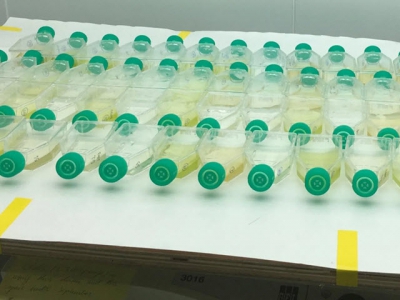Can microalgae be used to improve water quality in fish farms?

An energy-efficient system for cultivating marine microalgae that can improve water quality in aquaculture systems has been developed by researchers in Sweden.
The researchers selected the two most promising species from over 160 candidates. Photo. Cornelia Spetea Wiklund
The research project was a collaboration between the University of Gothenburg and RISE. It involved the study of around 160 species of microalgae from different places along the west coast of Sweden, in a bid to identify those that could extend the Nordic growing season, thus allowing an increase in the production of energy-rich algae biomass.
“We found a couple of suitable microalgae that live along the west coast, the diatom Skeletonema marinoi and the green algae Nannochloropsis granulata,” said Cornelia Spetea Wiklund, project leader and professor of plant cell physiology at the University of Gothenburg.
Since fish farms need feed sources and the fish and shellfish industries need to clean their process water, our blue solutions with microalgae are suitable for ex. in marine aquaculture
In their experiments, the calendar year was divided into three growing seasons: winter, spring and summer. Simulations with both algae species were conducted at different temperatures and light intensities in laboratory bioreactors using seawater.
“Skeletonema marinoi thrives and blooms more during the winter. Nannochloropsis granulata blooms more during the summer. Both grow equally well during the spring. Both are very effective in taking up nitrogen and phosphorus from seawater and converting nutrients into valuable biomass,” said Wiklund in a press release.
“Since fish farms need feed sources and the fish and shellfish industries need to clean their process water, our blue solutions with microalgae are suitable for ex. in marine aquaculture. Our microalgae could live on what is left in the process water while cleaning the water so that it can be recycled back into the production process.”
This makes it a closed and sustainable system. The only thing needed beyond this is energy from the sun and carbon dioxide from the air. The researchers have shown that biomass production using rotation cultivation with species adapted for different seasonal climates can be done, even during colder periods.
“Though the winter-adapted species are not as productive as those adapted to summer conditions, accounting for good access to sunlight, they can still be used to extend the growing season,” she explained.
According to a market survey commissioned by the project, algae biomass could be used in different ways as a bio-based raw material, such as for fertiliser or within the cosmetics, pharmaceutical and bioplastic industries. However, the greatest interest is currently from the aquaculture sector as means of improving water quality in fish farms.
“We have already applied for funding to start projects with several companies along the west coast,” said Wiklund.
Related news
 What is constraining production and export of shrimp and shutchi catfish?
What is constraining production and export of shrimp and shutchi catfish? For the shrimp industry, the increase of input costs has led to high product prices, reducing competitiveness in the international market.
 Shrimp export to Australia rose significantly
Shrimp export to Australia rose significantly The first quarter of 2021 witnessed a remarkable increase in shrimp export to Australia, in both value and the number of varieties.
 Ultimate Goal - A Modern and Sustainable Shrimp Industry
Ultimate Goal - A Modern and Sustainable Shrimp Industry At the first seminar of VietShrimp 2021, many ideas have been given and from these ideas, Shrimp Farming Solution has got a lot of attention.